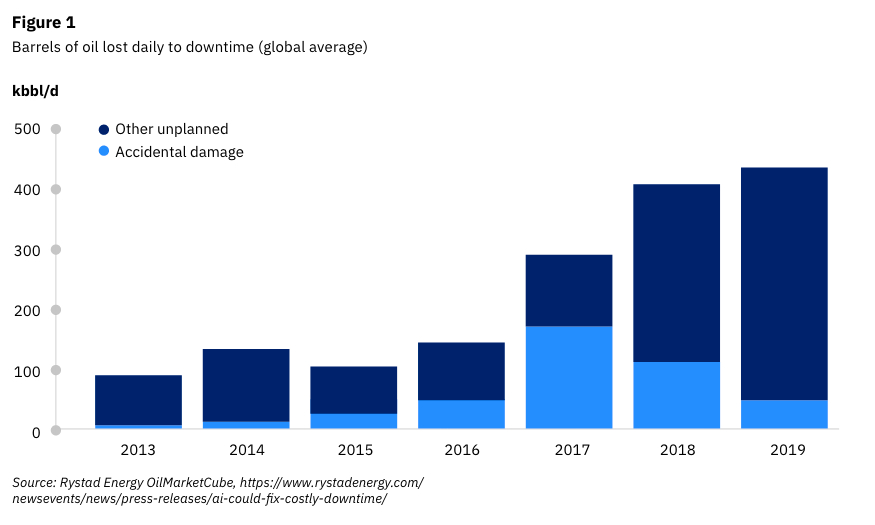How AI can pump new life into oilfields
The economic life of an oilfield
An oilfield is a business asset like any other where one must spend money to make money. When it comes to how the oil and gas industry invests to generate cash flow, unique aspects must be considered. These include operational risks, a long timeline, and significant obligations during and after cessation of production. But the primary investment objective is to fully realize the economic return of the field. To do so involves technical and economic disciplines in which artificial intelligence (AI) can have a significant and positive impact on performance.

The sweet spot for production optimization
Worldwide unplanned outages caused by damage or failure can result in production lags of thousands of barrels of oil per day (see Figure 1). While production losses caused by accidental damage are on the decline, unplanned failures are on the rise. An average offshore oil and gas company experiences about 27 days of unplanned downtime a year, which can lead to annual losses from USD 38 million to upwards of USD 88 million.

Here lies the sweet spot for production optimization where traditional predictive analytics can be augmented by AI-enabled predictions and natural language understanding. AI can help fix costly downtime by monitoring and predicting equipment failures and highlighting the business impact of unprepared loss of production capacity.
Production optimization is at the core of operations and critical workflow, and a fundamental capability for operators. It spans activities performed to get the greatest output from facilities and fields. While the objective might sound simple, it contains nuances that influence which disciplines will be involved and which decisions must be made.

The analytical approach can’t be static
Boosting daily hydrocarbon output from one surface facility is a contained optimization challenge, also referred to as “asset sweating.” Meeting hydrocarbon volume demand from multiple facilities that don’t all produce at their highest capacity requires multi-plant optimization. Optimization needs to extend to individual plant allocation, where cost, activities that impact production, and sustainability are sorted by short, mid, and long-term timeframes.
Historically, operators have used heuristic—or discovery—techniques to address complexities in modeling options to capture a current state and predict a future one. Today, discovery is a key aspect of machine learning—one subset of AI. For example, data discovery impacting production is the probability of machine failure under certain operational conditions. Data takes many forms: sensory from systems, volumes measured in production processes, or even weather forecasts that allow AI models to discover patterns that can highlight the risk of disruption.
Meet the authors
Ole Evensen, Leader, IBM Global Chemicals and Petroleum and Industrial Products Center of CompetencyDavid Womack, Global Director of Strategy and Business Development, Chemicals and Petroleum industry
Spencer Lin, Global Research Leader, Chemicals, Petroleum, and Industrial Products, IBM Institute for Business Value
Originally published 07 February 2020


